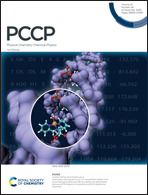Tritium diffusion in a Li2TiO3 crystal terminated with the (001) surface from first-principles calculations†
Abstract
The tritium release behavior of the Li2TiO3 crystal has become an important index to evaluate its comprehensive performance as a solid breeder material in nuclear fusion reactors. The tritium diffusion on the surface (surface diffusion) and diffusion from the inside to the surface (hopping diffusion) in Li2TiO3 crystals with a 1/3-Li(001) surface are systematically investigated by the first-principles method. Possible adsorption sites, diffusion pathways and energy barriers of surface diffusion and hopping diffusion have been calculated and analyzed, respectively. Tritium atoms are found to diffuse preferentially along the [100] direction on the surface and two equivalent pathways across the surface were identified. The obtained activation energies are about 0.50 eV for surface diffusion and 1.56 eV for hopping diffusion. The local density of states and Bader charge for typical surface diffusion and hopping diffusion pathways are calculated and analyzed. The results reveal that the tritium (T) atom bonds with neighboring oxygen (O) atoms during the surface diffusion, while the T–O interaction is significantly weakened in the hopping diffusion which results in the higher activation energy than that of surface diffusion. In combination with our previous work, a complete tritium diffusion model for the Li2TiO3 crystal is proposed and the corresponding tritium diffusion coefficients are obtained. Our obtained activation energies are in the same range as previous experimental data and could provide theoretical support for the future related experiments.



 Please wait while we load your content...
Please wait while we load your content...